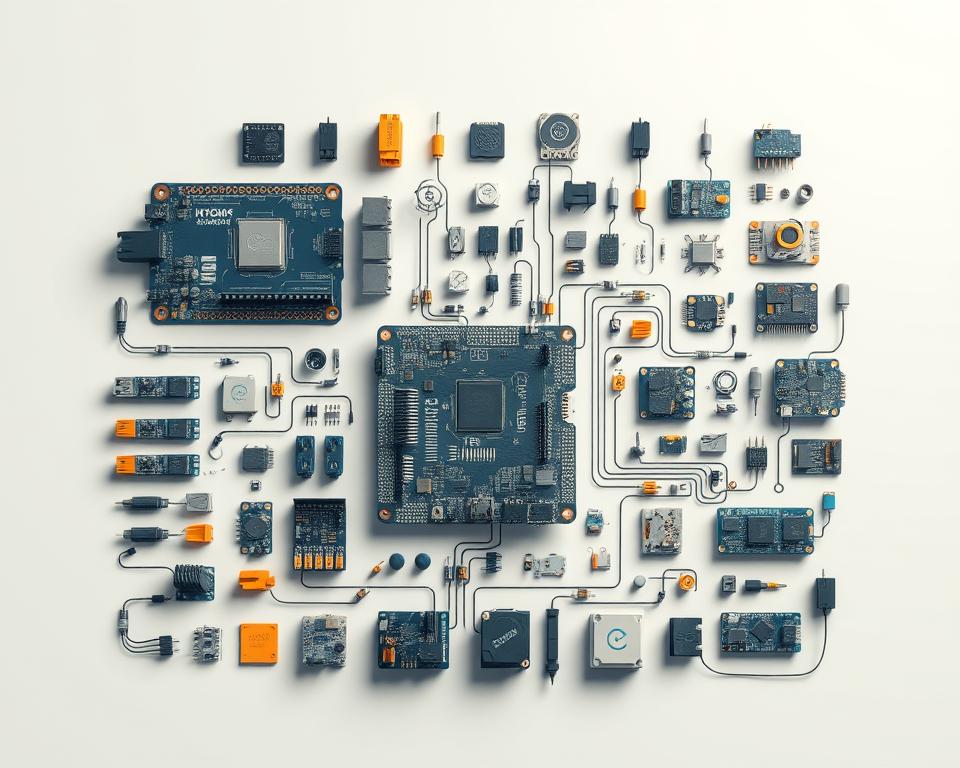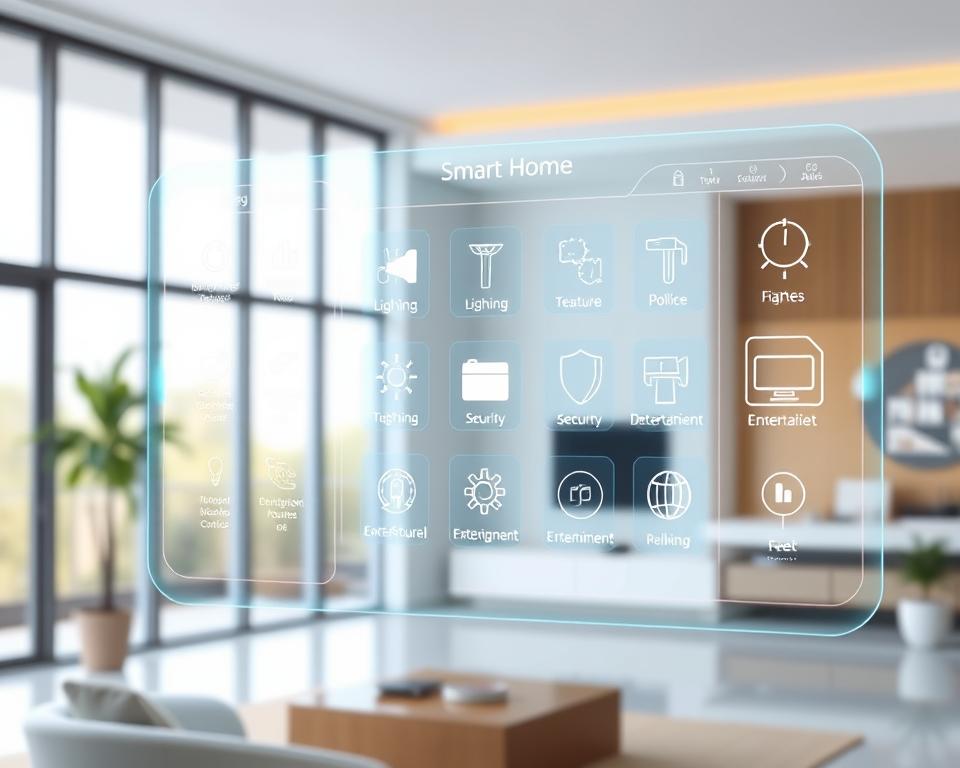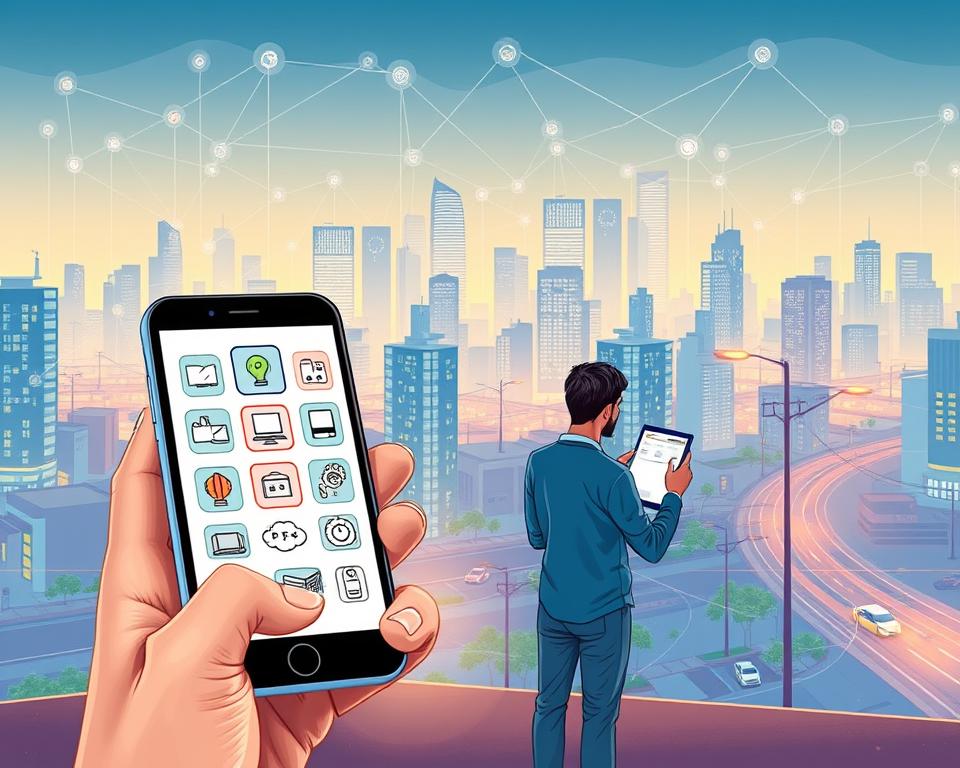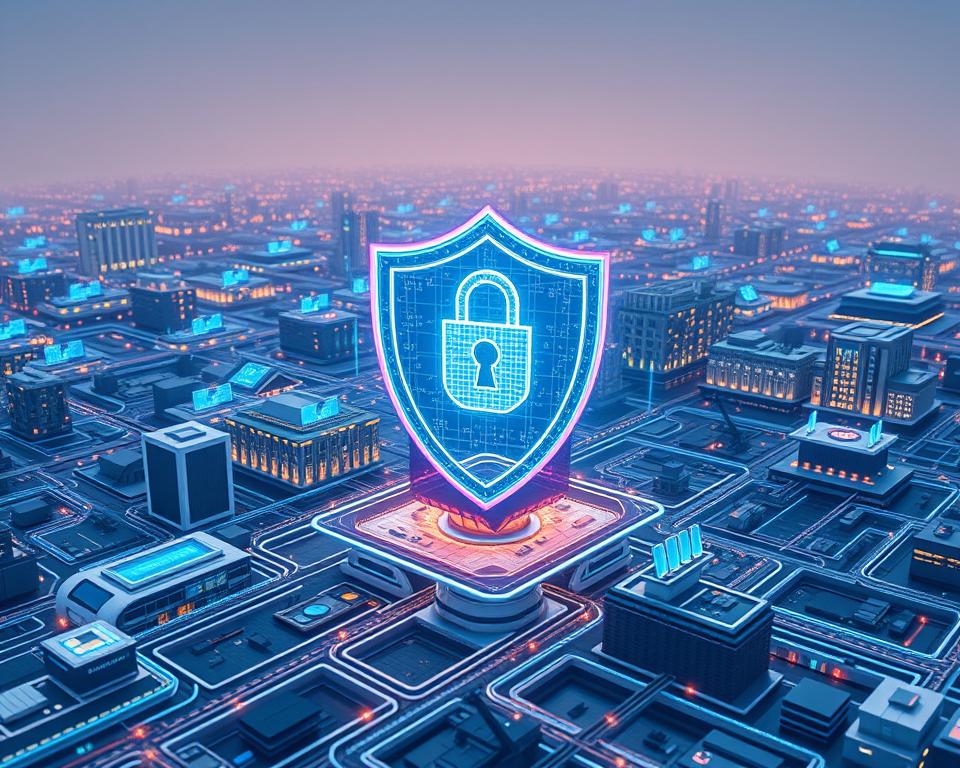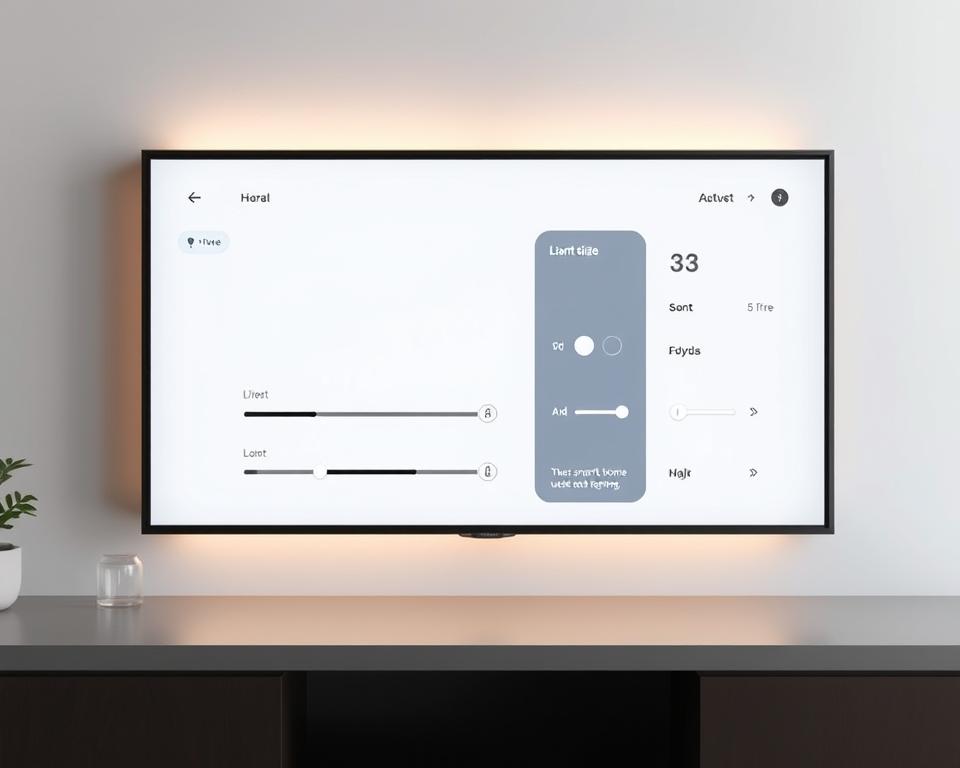IoT app development is changing how we live and interact with our surroundings. It’s especially true for smart home and smart city apps. With IoT technology, we can create innovative solutions that make our daily lives better. This includes smart home automation and smarter urban planning.
IoT app development connects and controls devices, making our lives easier and more sustainable. It’s key for creating seamless experiences in smart homes and cities. As we dive into IoT app development, we’ll see how it’s shaping our future homes and cities.
Table of Contents
Key Takeaways
- IoT app development is crucial for creating smart home and smart city applications
- IoT technology enhances our daily lives through innovative solutions
- Smart home automation is a key aspect of IoT app development
- IoT app development has the potential to revolutionize urban planning
- IoT technology connects and controls various devices for a seamless experience
- IoT app development is essential for creating sustainable and efficient living spaces
- Smart city applications rely heavily on IoT app development for intelligent urban planning
Understanding the IoT App Development Landscape
The Internet of Things (IoT) has changed how we live and interact with our world. IoT apps are making big changes in many industries. They are key in making homes and cities smarter, more efficient, and sustainable.
Today, IoT apps are especially popular in smart homes, with big names like Amazon and Google leading the way. Smart cities are also becoming more common, with cities worldwide using IoT to improve their services and infrastructure. Key players in these areas are pushing the boundaries of what’s possible, opening up new opportunities for growth.
Current Market Trends in IoT Applications
- Increased adoption of smart home devices
- Growing demand for smart city solutions
- Emergence of new IoT applications in industries like healthcare and transportation
The future of IoT app development looks very promising. The global IoT market is expected to hit $1.4 trillion by 2027. As IoT apps keep getting better, we’ll see even more innovative solutions that change our lives and work.
Key Players in Smart Home and Smart City Solutions
Siemens and Cisco are at the forefront of smart city tech. Apple and Samsung are leading in smart home solutions. These companies are investing a lot in research and development, driving innovation in the IoT field.
Growth Projections and Opportunities
The future of IoT apps is exciting, with lots of room for growth and innovation. As IoT tech keeps improving, we’ll see new and exciting things in smart homes and cities. These changes will transform how we live and interact with our surroundings.
| Industry | Growth Projection |
|---|---|
| Smart Home | 20% annual growth rate |
| Smart City | 25% annual growth rate |
Essential Components of IoT Applications
The development of IoT applications needs several key IoT components. These include hardware, software, and connectivity protocols. Together, they make a seamless IoT experience. This lets smart home devices and smart city infrastructure talk and share data.
A typical IoT system has:
- Sensors and devices that collect and transmit data
- Gateways that connect devices to the cloud or other networks
- Cloud-based platforms that process and analyze data
- Applications that provide users with insights and control
It’s important to integrate these IoT components well. This is key for making strong and efficient smart home devices and smart city infrastructure. By using these components, developers can make new IoT apps. These apps can make our lives better and improve city systems.
The IoT world is always changing. This means smart city infrastructure will become more important. It will lead to more advanced and connected IoT components. Knowing the essential parts of IoT apps helps developers find new ways to innovate and grow in the IoT market.
| Component | Description |
|---|---|
| Hardware | Sensors, devices, and gateways that collect and transmit data |
| Software | Cloud-based platforms and applications that process and analyze data |
| Connectivity Protocols | Protocols that enable communication between devices and networks |
Technical Requirements for Smart Home App Development
Understanding the technical needs is key for a smart home app. It involves looking at the IoT hardware and software parts. The aim is to make the app work smoothly and efficiently for users.
The first step is to outline the technical requirements. This means figuring out the IoT hardware needed, like sensors and gateways. The right hardware depends on the project’s needs, like what data to collect and how much automation is needed.
Next, the software stack requirements are considered. This includes the operating system, programming languages, and frameworks. The software choice depends on the project’s complexity and needed features.
Important things to think about in smart home app development include:
- Hardware compatibility
- Software scalability
- Connectivity protocols
- Data security
By carefully looking at these technical needs, developers can make smart home apps that work well and are easy to use. The success of a smart home app comes from balancing technical needs with user experience. This is best done with experienced developers who know the technical requirements well.
Smart City Infrastructure Requirements
Creating a smart city needs a solid smart city infrastructure. This includes IoT infrastructure and urban planning. It’s key for a city to be sustainable and efficient, meeting citizen needs. A good infrastructure can cut down traffic, boost safety, and improve life quality.
Key parts of a smart city infrastructure are:
- Smart transportation systems
- Energy-efficient buildings
- Intelligent waste management systems
- Advanced public safety systems
These parts work together for a smooth urban experience. For instance, smart transport systems can lessen traffic by better timing signals and routes. Energy-saving buildings cut down energy use and emissions.
A report by Next Big Technology shows blockchain’s role in securing IoT infrastructure. It’s vital in a smart city for secure data transmission.
In summary, a smart city needs a well-thought-out smart city infrastructure. It must include IoT infrastructure and urban planning. With these, cities can offer a sustainable, efficient living space for their citizens.
| Component | Description |
|---|---|
| Smart Transportation Systems | Optimize traffic signal timing and routing to reduce congestion |
| Energy-Efficient Buildings | Reduce energy consumption and lower greenhouse gas emissions |
| Intelligent Waste Management Systems | Optimize waste collection and disposal to reduce waste and increase recycling |
IoT App Development: How to Build Smart Home & Smart City Apps – Core Process
The IoT app development process has key steps to make apps for smart homes and cities. Knowing these steps helps developers make apps that work well and are easy to use.
Planning and architecture are at the heart of IoT app development. This stage sets the project’s goals, finds the users, and lists the app’s features. For smart home app development, this might mean linking with smart devices like thermostats. On the other hand, smart city app development could involve working with big systems like traffic and energy grids.
Key Steps in the IoT App Development Process
- Define project requirements and scope
- Design the application’s architecture and user interface
- Develop the application using suitable frameworks and technologies
- Test and debug the application to ensure functionality and security
By following these steps and thinking about the special needs of smart home app development and smart city app development, developers can make useful IoT apps. These apps meet the needs of their users.
Implementation and Integration
After making the app, it needs to be set up and linked with devices and systems. This might mean working with people like device makers and city officials. It’s important to make sure everything works well together.
| Application Type | Key Features | Integration Requirements |
|---|---|---|
| Smart Home App | Device control, energy monitoring, security features | Integration with smart devices, such as thermostats and security systems |
| Smart City App | Traffic management, energy grid management, public safety features | Integration with larger-scale infrastructure, such as traffic management systems and energy grids |
Security Considerations in IoT Development
When making IoT apps for smart homes and cities, IoT security is key. It’s vital to keep user data safe and stop threats. Securing the link between devices and the cloud is a big part of smart home security.
Developers can use encryption and secure login methods to do this. For smart city security, protecting important infrastructure and services is needed. This includes using strong security tools and plans for when something goes wrong.
IoT development faces threats like:
- Data breaches
- Device hacking
- DDoS attacks
To fight these, developers should update software often, use safe data transfer methods, and control who can access what. For more onsmart home app development, check out online guides and reports.
By focusing on IoT security, developers can make sure their apps are safe and reliable. This is especially crucial for smart city security, where a breach could have big consequences.
| Security Measure | Description |
|---|---|
| Encryption | Protects data in transit and at rest |
| Authentication | Verifies the identity of devices and users |
| Intrusion Detection | Monitors for potential security threats |
Data Management and Analytics Integration
Effective IoT data management is key for smart homes and cities. It involves collecting, processing, and analyzing lots of data. Smart home data analytics and smart city data analytics help make better decisions and improve life for citizens.
To do this, many data collection methods are used. These include sensor data, user input, and data from outside sources. The data is then processed and stored using advanced solutions like cloud computing and data lakes.
Data Collection Methods
- Sensor data collection
- User input and feedback
- External data sources such as weather and traffic data
Processing and Storage Solutions
IoT data management needs strong processing and storage solutions. This includes using IoT data management platforms and data analytics tools. Machine learning algorithms help extract insights from the data.
Analytics Implementation
The last step is to use analytics solutions to get insights from the data. This includes smart city data analytics and smart home data analytics. These help optimize energy, traffic, and waste management, among other things.
| Application | Benefits |
|---|---|
| Energy Management | Optimized energy consumption, reduced waste |
| Traffic Management | Improved traffic flow, reduced congestion |
| Waste Management | Efficient waste collection, reduced environmental impact |
User Interface Design for IoT Applications
A well-designed IoT user interface is key for a smooth user experience. A good smart home UI or smart city UI should be easy to use. It should also give users the info they need to manage their devices.
Developers should aim for a design that focuses on the user. This means considering what the target audience needs and wants. This approach ensures the interface meets their expectations.
Designing an effective IoT user interface involves simplicity, consistency, and feedback. A simple design makes it easy for users to understand how to use the app. Feedback, like notifications, keeps users updated on their devices.
For more on designing great IoT user interfaces, check out this guide on using Flutter to improve IoT.
- Improved user experience
- Increased user engagement
- Enhanced device control and monitoring
By focusing on user interface design, developers can make IoT apps that are both useful and fun. This leads to more people using and sticking with the apps.
Testing and Quality Assurance Protocols
Ensuring the quality of IoT applications is key to their success. IoT testing is vital in the development process. It helps find and fix bugs for a smooth user experience. In smart home testing and smart city testing, it’s more complex due to many devices and systems.
To ensure IoT application quality, developers must do detailed performance testing, security testing, and user experience testing. This includes:
- Checking how the app performs under different loads and conditions
- Finding and fixing security risks
- Making sure the app is easy to use
By sticking to these testing steps, developers can make sure their IoT apps meet high standards. This is crucial in smart home testing and smart city testing. Here, the impact on daily life and public services is high.
Good IoT testing and quality checks are key to gaining user trust. They help build a reputation for reliability and excellence. By focusing on testing and quality, developers can make IoT apps that work well, are secure, efficient, and easy to use.
Common Challenges and Solutions
Creating IoT apps for smart homes and cities comes with big hurdles. One big IoT challenge is keeping user data safe and private. With more devices online, the risk of hacking and data loss grows.
Another big hurdle is fixing smart home challenges like getting different devices to work together. This can be solved by using standard ways for devices to talk to each other. This makes it easier for them to work together smoothly.
For smart city challenges, managing lots of data from sensors is a big worry. But, using smart data analysis and AI can help. This way, cities can make better choices and improve life for everyone. For more on IoT smart home app development, check out this guide.
Some common ways to tackle these problems include:
- Using strong security like encryption and checks to make sure data is safe
- Creating open APIs and protocols to help devices work together
- Using cloud services to handle and understand big data sets
By tackling these issues, developers can make IoT apps better for smart homes and cities. This makes life better for everyone in the community.
| Challenge | Solution |
|---|---|
| Security and privacy concerns | Implementing robust security measures |
| Device compatibility issues | Developing open-source APIs and protocols |
| Data management and analysis | Utilizing cloud-based data analytics platforms |
Integration with Existing Systems
When making IoT apps, it’s key to think about IoT integration with current systems. This makes things work smoothly and efficiently. It’s about linking up different devices and systems to make everything better.
Integrating involves a few steps:
- API development to let systems talk to each other
- Legacy system integration to work with what’s already there
- Cross-platform compatibility for easy use between devices and systems
By doing IoT integration, smart home integration, and smart city integration well, developers can make a better IoT world. This leads to better experiences, more productivity, and a better life for everyone.
As the IoT world keeps changing, linking up with existing systems will become even more important. By focusing on smart home integration and smart city integration, developers can lead the way. They can make new, useful solutions that help users and businesses thrive.
Scaling IoT Applications
IoT applications are becoming more common in smart home and smart city settings. IoT scaling is key for smooth operation and handling data well. Good scaling helps IoT apps grow with more users and data.
For smart home scaling, think about device compatibility, network size, and storage. This way, developers make IoT apps that grow with smart city needs. It helps in better urban planning and management.
For smart city scaling, use flexible and adaptable systems. This lets cities add new devices and data sources easily. It makes cities better for living, more sustainable, and efficient.
Some top tips for IoT scaling are:
- Use modular, microservices-based designs
- Choose cloud-based setups and services
- Make sure security and data protection are strong
By following these tips and focusing on scalability, developers can make IoT apps that help smart home and smart city growth. This drives innovation and improves urban life in many ways.
Maintenance and Updates
Regular IoT maintenance is key to keeping IoT apps running well. This includes smart home maintenance and smart city maintenance. These tasks help keep systems running smoothly and fix problems before they start.
Some important parts of maintenance and updates are:
- Regular software updates to fix bugs and improve security
- Monitoring system performance to identify potential issues
- Updating hardware and firmware to ensure compatibility and efficiency
Good update management and version control are also vital. They help make changes smoothly and keep the system running well. By focusing on maintenance and updates, organizations can keep their IoT apps working great. This gives users a better experience.
Cost Considerations and ROI Analysis
When we talk about IoT for smart homes and cities, we must think about the IoT cost and ROI. Knowing the costs and benefits helps us make smart choices.
The smart home cost includes hardware, software, and upkeep. Here’s a look at these costs:
- Hardware costs: devices, sensors, and infrastructure
- Software costs: development, licensing, and integration
- Maintenance costs: updates, support, and repairs
The smart city cost is more extensive. It includes:
- Infrastructure development: roads, public transportation, and utilities
- Technology integration: IoT sensors, data analytics, and security
- Services and maintenance: waste management, public safety, and healthcare
| Category | Cost | Benefit |
|---|---|---|
| Smart Home | $100,000 | $150,000 |
| Smart City | $1,000,000 | $1,500,000 |
Understanding the IoT cost and benefits helps us make better choices. This leads to a higher ROI for our smart home and city investments.
Future-proofing Your IoT Applications
The Internet of Things (IoT) is always changing. It’s key to think about IoT future-proofing when making smart home and city apps. This means making apps that can grow with new tech, staying useful and effective.
To make smart home future-proofing work, developers need to design with flexibility in mind. They should use modular designs and open standards. This lets apps easily add new features and work with new devices. This way, apps can keep up with the fast pace of IoT.
For smart city future-proofing, we must think about the future impact of IoT. This includes how new tech like 5G and AI will change smart city systems. By planning ahead, cities can build apps that meet today’s needs and tomorrow’s possibilities.
- Using open standards and APIs to facilitate integration and interoperability
- Designing modular architectures that allow for easy updates and expansions
- Implementing robust security measures to protect against emerging threats
- Continuously monitoring and evaluating the application’s performance and effectiveness
By focusing on IoT future-proofing, developers can make apps that stay useful and secure. This brings more value and benefits to users in the long run.
Conclusion
As we wrap up our exploration of IoT app development, it’s clear that smart home and city apps are key. They help us build a more connected and efficient world. This field is exciting and keeps changing fast.
There are endless possibilities in IoT app development. Developers can make life better for people and communities. They can improve home security, use energy better, and help with city planning.
The need for IoT apps is growing fast. Developers need to keep up with new tech and trends. This way, they can create new and exciting apps for homes and cities, shaping the future of IoT.









